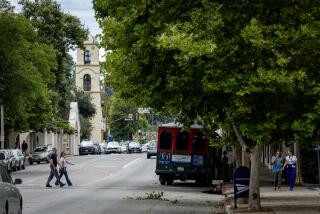The Taj of Ojai : Intriguing Replica of Shrine, a Local Landmark, Retains Its Exotic Aura
The original Taj Mahal in India is one of the worldâs most lavish shrines, encompassing a 34,796-square-foot mausoleum topped by a gleaming white marble dome 12 stories tall.
The replica outside Ojai has four bedrooms, four bathrooms, three kitchens, a living room, a dining room, and a drawing studio that lately was a feed shed for ostriches. The reflecting pool has sprung a leak and thereâs been a bit of a bug problem in the meditation room, but the domicile known locally as âthe Tajâ can be Om Sweet Om for anyone with $275,000 or, preferably, an interesting property to trade.
All that is contingent, of course, on the consent of the owner, one Tadeusz Kanigowski, a reputed Polish count from South Africa said to also own properties in England, South Africa, the Cayman Islands, Bolivia and elsewhere. Two offers on the property are languishing, according to the propertyâs listing agent, Carla Bard, because nobody can find Kanigowski for his approval.
âWe last heard from him in Amsterdam,â said Linda Matthew, the Tajâs tenant and a longtime friend of the count. âHeâll contact us. He always does.â
On the market for nearly two months, the 57-year-old Taj--formally dubbed The Pleiades--is something of an Ojai landmark. Tour buses thread through the workaday subdivision surrounding it. Guidebooks give it a paragraph, and pilgrims to spiritually aware Ojai, where meditative outlets far outnumber steak houses, wander through regularly.
âWe have people show up thinking itâs an ashram,â said Matthew. âThey just walk right in and say, âWhereâs the office? Where do we sign up?â
There is no sign-up sheet. Matthew, her Rhodesian-born husband, Patrick, and their 6-year-old son have lived in the Taj almost four years with nary a disciple. Linda weaves tapestries--dreamy, soft-edged landscapes in wool and mohair--on a room-sized loom in one wing. Across the reflecting pool, Patrick designs and assembles computer gear.
The odd marriage of medieval and modern--the couple once designed a computerized loom--comes together beneath the dome, where the family lives. The floors are hardwood, the ceilings are high and the rooms are cool.
The living room is spartan. A guitar rests on an easy chair, and a volume of e.e. cummings poetry lies on the coffee table. A stuffed baby ostrich, the unfortunate runt of a dozen that were raised in the backyard until they proved too big to handle, sits on a shelf.
When the Taj was built in 1930 by Edward Martin, a retired English Army officer turned clergyman, the room was a chapel. Martin also was a devotee of Jiddu Krishnamurti, the philosopher who taught in Ojai, and hoped to establish a bond with him through the Taj, according to Matthew, who has studied the houseâs history extensively.
But the Taj Mahal does not figure at all in the teachings of Krishnamurti, who repeatedly warned his followers against deifying him or enshrining his works.
Krishnamurti apparently fended off the more aggressive entreaties of the eccentric Englishman. But, even without a resident sage, the Taj drenched its first owners in spirituality.
Letter Written by Widow
A 1974 letter written by Martinâs widow, Rhoda, conveys the kind of luminescent exchange that must have been commonplace in the early days around the ersatz shrine:
âIt was on a beautiful summer night,â wrote Rhoda. âWe were on the roof watching the sun set behind Topa Topa when I saw seven bright stars above us, and asked Edward, who was versed in star lore, what that particular constellation was named. He watched it for minutes in silence and said the Pleiades, or Seven Sisters, and told me a romantic story of seven sisters being turned into stars--and added--âLet us name the house for them,â and so it was! The workmen, however, found the name difficult and called it, sometimes, âLa Casa Blanca.â â
Rhoda Martin also recalled the serene excitement of a visit from Krishnamurti:
âWhen the moon was full and shone like a great golden orb over the cupolas of the Pleiades, Krishnamurti would drive his limousine--it was, I believe, a gift of Lady Delaware, but Iâm not certain of that--anyway, he would watch the moon rise and its glittering rays sparkled in the lily pool where the goldfish jumped to catch mosquitoes settling on the water.â
Over the years, such moments faded.
The Taj changed hands five times. It fell into disrepair and foreclosure.
âWhen we came, it was a total mess,â said Matthew. âA tenant with three kids had lived here a year and a half without paying rent. They threw spaghetti and chicken bones in the reflecting pool. There were old mattresses lying around. We had to strip enamel paint off some of the mosaic tiles, and we had to redo all the floors.â
One wing of the Taj was used for storage, and was crammed with refrigerators, filing cabinets, dune buggies and other heavy items. Strangers would drift in to claim possessions both earthly and ethereal.
âI went upstairs to the meditation room one time,â Matthew said, âand found a Hare Krishna sitting there--just sitting there.â
âPicked Up Negativityâ
Even more disquieting was an unfocused feeling of evil wafting through the place. Just last month, the Matthews had a Tucson couple named Shirle and Myron Nelson sweep the Taj clean of malevolent ethers.
âI picked up the negativity immediately,â said Shirle, who consults a âguiding entityâ to aid the troubled and the ill. âI picked up that this Martin was a glory seeker. He was out to manipulate this beautiful man, Krishnamurti, but Krishnamurti was much wiser.
âI felt love from the architect, and from the Mexicans who built it,â she said, âbut not from Martin. He was a phony.â
Even worse, said Shirle, it was apparent to her that some previous tenant had practiced a black magic whose reverberations had lingered in the walls of the Taj. âI saw the serpent,â she said.
All that is gone now, of course.
âWe cleared out all the negativity and we blessed the place,â said Shirle. âIt feels very good. There is love there.â
Weeds are being plucked from the hedgerows, and the Chinese elm beetles that swarmed through a light fixture into the meditation room have been dispatched.
âThe house is smiling now,â said Matthew. âItâs not true to Indian feeling as it was built, but there is definitely some truth in it.â
More to Read
Sign up for The Wild
Weâll help you find the best places to hike, bike and run, as well as the perfect silent spots for meditation and yoga.
You may occasionally receive promotional content from the Los Angeles Times.







